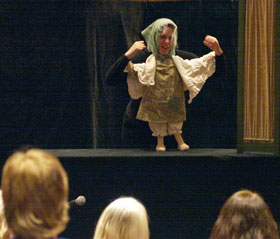Event Brings Puppetry, Sign Language Together
 |
| Sara Frechette, a graduate of the puppet arts program, performs with a signing puppet during a symposium titled “Body Language” on April 15. |
|
Photo by Jordan Bender |
The arch of an eyebrow, the flutter of a finger, or the turn of a wrist can convey a story rich in detail and emotion. Both puppetry and American Sign Language employ such gestures to communicate.
On April 15, UConn faculty and students in the puppet arts and American Sign Language (ASL) programs met to explore the similarities between their two fields during a first-time symposium titled “Body Language.”
The event, held in the Konover Auditorium, was designed to discover opportunities for collaboration that could raise awareness of deaf culture, improve early language acquisition, engage more people in the arts, and reduce barriers between the deaf and hearing communities. Sponsors included the School of Fine Arts, the Department of Linguistics, the University’s American Sign Language Club, and the Office of the Vice Provost for Research and Graduate Education.
Organizers sought to tap into the growing popularity of ASL as a second language on college campuses nationwide and the University’s exceptional resources in the field of puppetry. UConn is the only university in the country to offer both bachelor’s and master’s degrees in puppetry.
Alumna Sarah Frechette, who earned a bachelor of fine arts in puppetry in 2001 and also took ASL courses at UConn, demonstrated two three-foot-tall puppets that she created to perform sign language for the audience. She designed the puppets at UConn’s puppetry lab for her ASL final.
“My goal was to design a puppet that would completely immerse itself into deaf culture,” said Frechette, who first started learning sign language as a child when doctors told her parents it appeared she would lose her hearing.
Frechette, who did not lose her hearing, started taking courses again at UConn and advocated for them to count as foreign language credits, which they now do, she said.
She has performed with her signing puppets at the American School for the Deaf and the National Theatre of the Deaf in West Hartford, as well as at festivals.
Frechette said she and puppetry alumnus Michael Carolan also are working on videos with puppets that sign, hoping to engage deaf children at an early age and also interest their hearing parents in learning sign language with them.
During the symposium, she performed The North Wind and the Sun and The Emperor’s New Clothes without music. She also narrated her stories for hearing members of the audience, calling the narration “captioning for the signing impaired.”
“To be able to perform a piece in silence and engage the audience is gold,” she said. “It’s the sign of a really good performer and a really good puppet.”
ASL instructor Doreen Simons- Marques said puppetry could aid deaf education. “Deaf children are so visual, but interpreters are sometimes so stale. They just sign the letters for the word ‘ball,’ for instance, with no expression,” she said. “Puppets hold wonderful potential for concept building and language acquisition.”
As part of the event, Simons-Marques gave a presentation on deaf culture and Bart Roccoberton, professor of dramatic arts, discussed the visual language of puppetry and introduced a handful of silent student puppet performances.
UConn has recently expanded its ASL offerings from one to three classes, and these now count as foreign language classes, Simons-Marques said.
At the end of the symposium, presenters discussed bringing ASL students to puppetry classes and more puppetry students into ASL courses, and also having actors from the National Theatre for the Deaf lead a master class for ASL and puppetry students together.

